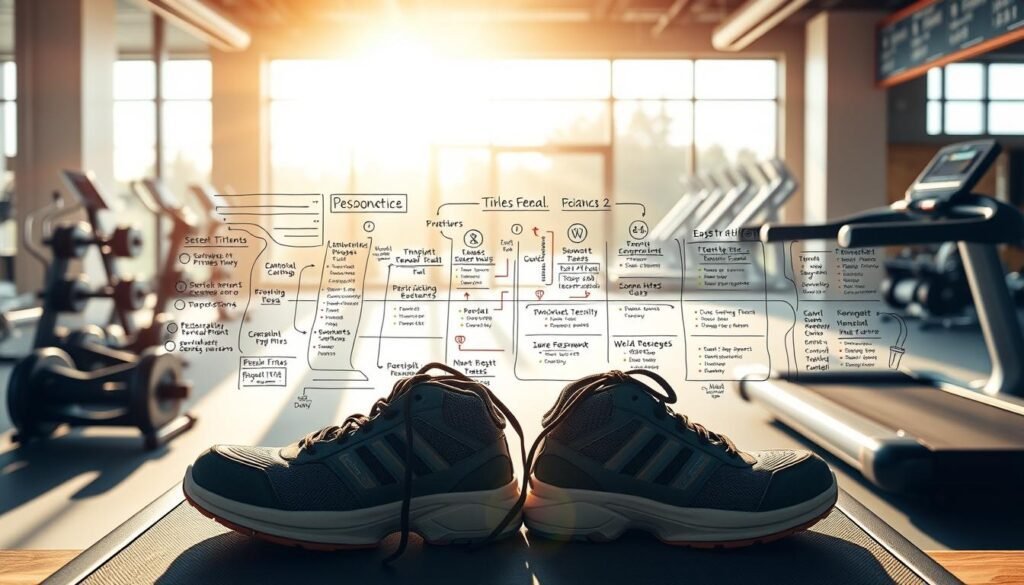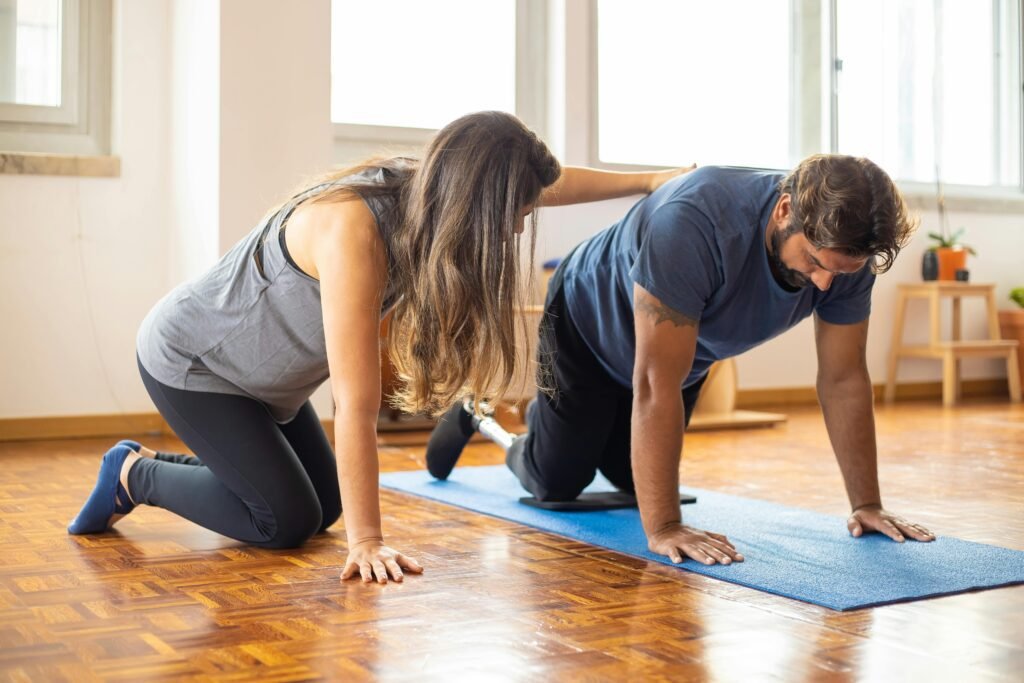
Starting a fitness transformation journey is both exciting and scary. It needs dedication, toughness, and the right advice. As you aim to boost your health and wellness, picking strategies that inspire and keep you going is key.
Thank you for reading this post, don't forget to subscribe!Changing your fitness journey is not just about looking good. It’s about living a life that boosts your wellness overall. By adding inspiring strategies to your daily life, you can become a healthier, more balanced version of yourself.
Key Takeaways
- Set clear and achievable fitness goals
- Incorporate a balanced diet into your lifestyle
- Stay hydrated and get enough rest
- Find a workout routine that you enjoy
- Track your progress and stay motivated
The Power of Committing to Fitness Transformation
Committing to fitness is more than just changing your body. It’s about changing your whole life. Regular exercise improves your body and mind, making you feel better overall.
Understanding the Holistic Benefits of Regular Exercise
Regular exercise is key to feeling good. It makes your heart healthier, boosts your energy, and makes you stronger. It also helps your mind, reducing stress and improving your mood.
How Fitness Transforms More Than Just Your Body
Fitness changes you in many ways, not just physically. As you get fitter, you’ll feel more energetic, sleep better, and feel more confident.
Physical, Mental, and Emotional Transformations
The benefits of fitness fall into three main areas:
| Physical Transformations | Mental Transformations | Emotional Transformations |
|---|---|---|
| Increased strength and endurance | Improved mental clarity and focus | Enhanced emotional resilience |
| Weight management and improved body composition | Reduced stress and anxiety | Better mood regulation |
| Improved cardiovascular health | Boosted self-esteem and confidence | Increased emotional well-being |
By committing to fitness, you’re changing your whole self. This all-encompassing approach to fitness is incredibly powerful and life-changing.
Mindset Matters: Cultivating a Transformation Mentality
A growth mindset is key to successful fitness changes. It shows that your skills and smarts can grow with effort and hard work.
Developing a Growth Mindset for Fitness Success
Getting a growth mindset means facing challenges and seeing failures as chances to grow. In fitness, it’s about trying new moves, pushing through hard workouts, and learning from mistakes.
Key characteristics of a growth mindset include:
- Embracing challenges as opportunities for growth
- Persistence in the face of obstacles
- A willingness to learn from failures
Overcoming Mental Barriers and Self-Doubt
Mental blocks and self-doubt can slow down your fitness progress. Using positive self-talk and visualization can help beat these hurdles.
Techniques for Positive Self-Talk and Visualization
Positive self-talk uses affirmations to boost your confidence and drive. Visualization is about imagining yourself succeeding. Both can build a strong, positive mindset.
| Technique | Description | Benefits |
|---|---|---|
| Positive Self-Talk | Using affirmations to boost confidence | Increased motivation, reduced self-doubt |
| Visualization | Mentally rehearsing successful outcomes | Improved focus, enhanced confidence |
Adding these techniques to your fitness plan can help you reach your goals. Remember, a strong mindset is as crucial as a strong body.
Setting SMART Fitness Goals That Inspire Action
To improve your fitness, setting SMART goals is key. SMART stands for Specific, Measurable, Achievable, Relevant, and Time-bound. It helps you set clear, reachable goals.
Creating Specific and Measurable Objectives
Start by making your goals specific and measurable. Instead of “I want to be healthier,” say “I aim to reduce my body fat percentage from 25% to 20%.” This makes your goal clear. Measurable goals let you track your progress, keeping you motivated.
“You don’t have to be great to start, but you have to start to be great.” Zig Ziglar’s quote highlights the importance of starting. Specific and measurable goals guide you towards success.
Balancing Ambitious Goals with Realistic Expectations
It’s good to aim high, but don’t set goals that are too high. Aim for something you can realistically achieve. For example, losing 1-2 pounds a week is better than trying to lose 10 pounds in a week.
Short-term vs. Long-term Goal Setting
Long-term goals give you direction and purpose. For example, a short-term goal might be to exercise for 30 minutes, three times a week. A long-term goal could be to run a marathon in six months.
Understanding and using SMART fitness goals helps you plan your fitness journey. This method not only helps you reach your fitness goals but also keeps you improving and succeeding.
Designing Your Personal Fitness Roadmap

To improve your fitness, you need a plan that fits you. A good fitness plan guides you through your journey. It helps you stay focused and on track.
Assessing Your Current Fitness Level
First, check where you are now. Look at your strength, endurance, and flexibility. Use tests, body checks, and activity tracking to see how you’re doing.
Creating a Progressive Training Schedule
Having a plan that gets harder over time is key. This means your workouts should get more intense or last longer. It keeps your body challenged and growing.
Sample Weekly Plans for Different Fitness Levels
Here are weekly plans for different levels:
- Beginner: 3 days of moderate cardio and 2 days of strength training
- Intermediate: 4 days of cardio, 2 HIIT sessions, and 3 days of strength training
- Advanced: 5 days of cardio, 3 HIIT sessions, and 4 days of strength training with plyometrics
By following these tips, you can make a fitness plan that works for you. This will help you reach your fitness goals in a structured way.
Strength Training: Building Your Foundation for Transformation
Strength training is more than just lifting weights. It’s about making you stronger and healthier from the start. This key part of fitness is vital for your overall health and toughness.
Essential Compound Movements for Total Body Strength
Compound movements work many muscles at once. They are great for building strength all over your body. Examples are squats, deadlifts, bench presses, and rows. These exercises are key because they help you move like you do in real life and work on your joints.
- Squats: Works the legs, glutes, and core.
- Deadlifts: Engages the back, legs, and glutes.
- Bench Presses: Targets the chest, shoulders, and triceps.
- Rows: Strengthens the back, shoulders, and arms.
Progressive Overload: The Key to Continuous Improvement
Progressive overload means slowly adding more weight or reps to keep challenging your muscles. This is key to growing stronger and avoiding getting stuck in a fitness rut.
Strength Training for Different Body Types and Goals
Everyone’s body is different, and so is how they respond to working out. Knowing your body type and fitness goals helps you create a workout plan that’s just right for you.
Equipment Options from Home to Gym Settings
You can work out at home or at the gym with different tools. Here are some options:
| Equipment Type | Home/Gym | Benefits |
|---|---|---|
| Dumbbells | Both | Versatile, works multiple muscle groups |
| Resistance Bands | Home | Portable, easy on joints |
| Leg Press Machines | Gym | Targets legs, adjustable resistance |
Adding strength training to your routine starts a journey to better strength and health. It’s a big step towards a stronger, happier you.
Cardiovascular Fitness: Energizing Your Transformation Journey
Cardiovascular fitness is key to energizing your transformation journey. It helps your body burn calories, improves heart health, and boosts stamina. Adding effective cardiovascular exercises to your routine can greatly improve your fitness journey.
Finding the Right Cardio Activities for Your Preferences
Finding activities you enjoy is crucial for a consistent cardio routine. You can choose from running, cycling, swimming, or dancing. Trying different cardio activities can help you find what fits your lifestyle and preferences.
Some popular cardio activities include:
- Running or jogging
- Cycling or spin classes
- Swimming or water aerobics
- High-Intensity Interval Training (HIIT)
- Dancing or Zumba
HIIT vs. Steady-State Cardio: Benefits and Applications
It’s great for burning calories and improving heart health quickly.
Steady-state cardio, on the other hand, involves maintaining a moderate intensity over a longer period. It’s good for improving endurance and burning fat.
| Cardio Type | Benefits | Applications |
|---|---|---|
| HIIT | Time-efficient, improves cardiovascular health, burns calories | For those with limited time, looking to boost metabolism |
| Steady-State Cardio | Improves endurance, burns fat, enhances cardiovascular health | For endurance training, fat loss, and cardiovascular improvement |
Integrating Cardio into Your Weekly Routine
To maximize your cardiovascular fitness, integrate cardio into your weekly routine. Aim for at least 150 minutes of moderate-intensity cardio or 75 minutes of vigorous-intensity cardio each week.
“Consistency is key when it comes to cardio. Find a routine that works for you and stick to it.”
By balancing cardio with other exercises and listening to your body, you can create a well-rounded fitness plan. This supports your transformation goals.
Flexibility and Mobility: The Overlooked Elements of Fitness
Flexibility and mobility are key to a successful fitness journey. They boost performance and lower injury risk. A good fitness plan should include exercises that improve these areas.
Why Mobility Matters for Long-term Fitness Success
Mobility is vital for everyday movements and sports performance. Good mobility lowers injury risk by letting joints move fully. This improves physical function.
Effective Stretching Routines for Recovery and Performance
Adding stretching to your routine boosts recovery and performance. Dynamic stretching before exercise gets muscles ready. Static stretching after exercise helps recover and increases flexibility.
| Type of Stretching | Timing | Benefits |
|---|---|---|
| Dynamic Stretching | Pre-exercise | Prepares muscles for activity, improves range of motion |
| Static Stretching | Post-exercise | Aids in recovery, improves flexibility |
Incorporating Yoga and Mobility Work into Your Schedule
Yoga and mobility exercises are great for fitness. They boost flexibility, balance, and mobility. Try adding a yoga or mobility session 2-3 times a week for better fitness.
Focus on flexibility and mobility to improve your fitness journey. It reduces injury risk and boosts physical function.
Nutrition Strategies to Fuel Your Fitness Transformation
Nutrition is key to fueling your fitness journey. A good nutrition plan boosts your exercise and helps you reach your goals. It makes sure you get the best results.
Macronutrients and Their Role in Body Transformation
Knowing about macronutrients is important for a good diet. Proteins, carbohydrates, and fats are the base of a balanced diet. Each one plays a special role in changing your body.
- Proteins help fix and grow muscles.
- Carbohydrates give you energy for workouts and daily life.
- Fats help make hormones and keep you healthy.
It’s important to balance these nutrients for a successful transformation.
Meal Timing and Frequency for Optimal Results
Meal timing and frequency greatly affect your fitness. Eating the right foods at the right time boosts performance, helps with recovery, and supports muscle growth.
Eating a mix of proteins and carbs after working out helps with recovery and building muscle.
Hydration: The Foundation of Performance and Recovery
Hydration is crucial for performance and recovery. Drinking enough water helps your body work well and supports your fitness goals.
Meal planning can be tough, especially when you’re busy. But, simple steps like batch cooking, meal prepping, and planning meals around your workouts can help a lot.
Spending a few hours on the weekend on meal prep can ensure you have healthy meals all week. This supports your fitness journey.
The Science of Fitness: Understanding How Your Body Changes
Starting your fitness journey can be exciting and educational. It’s not just about working out. It’s about how your body changes through science.
Muscle Growth and Adaptation
Muscles grow when you challenge them with exercise. This is called hypertrophy. When you do resistance training, your muscles get a bit damaged.
Then, your body fixes these damages by making your muscles stronger and bigger. This is all thanks to special signals in your cells and hormones.
Key factors influencing muscle growth include:
- Nutritional support: You need enough protein to help your muscles repair and grow.
- Progressive overload: Increasing the intensity of your workouts helps your muscles keep adapting.
- Rest and recovery: Your muscles need time to heal and grow.
Metabolic Changes
When you start exercising, your metabolism changes a lot. Aerobic exercises help your body use fat better. This makes you last longer and lose fat.
Also, as you build muscle, your body burns more calories even when you’re not moving. This is because your resting metabolic rate (RMR) goes up.
Metabolic adaptations include:
- Increased mitochondrial density: This means your body can make energy more efficiently.
- Enhanced insulin sensitivity: This helps your body take in glucose better and lowers the risk of metabolic problems.
- Changes in hormone levels: Hormones like growth hormone and adiponectin help with fat loss and muscle gain.
Hormonal Responses
Hormones are very important when it comes to exercise and recovery. Hormones like testosterone and growth hormone help your muscles grow and repair. But, too much cortisol can break down your muscles.
“Understanding the hormonal responses to exercise can help you optimize your training and recovery strategies.”
Knowing how your body changes can help you make better choices for your fitness journey. It’s all about understanding the science behind the changes.
Recovery and Rest: Essential Components of Progress

Achieving fitness goals is not just about working out. It’s also about knowing how important recovery and rest are. When you push your body hard, it’s during rest that your muscles fix and grow. So, recovery is key to your fitness journey.
The Science of Muscle Recovery and Growth
Strength training or exercise causes tiny tears in your muscles. It’s during rest that your body fixes these tears, making your muscles stronger. This process needs good nutrition, enough rest, and hydration. Knowing how it works can help you recover better.
Sleep Quality and Its Impact on Fitness Goals
Sleep is vital for recovery. It’s when your body releases hormones that help repair and grow muscles. Bad sleep can slow down your fitness progress. So, getting quality sleep is just as important as your workouts.
Active Recovery Techniques for Continuous Improvement
Active recovery means doing low-intensity exercises to keep blood flowing without straining your muscles. Activities like yoga, light cardio, and stretching help keep you flexible and reduce soreness.
Recovery Tools and Technologies Worth Investing In
There are tools and technologies that can help with recovery, like foam rollers, compression garments, and recovery boots. They improve blood flow and reduce soreness, making them great for your recovery routine.
| Technique | Description | Benefits |
|---|---|---|
| Foam Rolling | Self-myofascial release technique | Reduces muscle soreness, improves circulation |
| Compression Garments | Garments that provide compression | Enhances blood flow, reduces swelling |
| Recovery Boots | Sequential compression devices | Improves circulation, reduces muscle soreness |
Understanding and using good recovery strategies can really boost your fitness. It’s about finding a balance between exercise and rest. This way, your body has what it needs to recover and grow.
Tracking Your Fitness Journey: Metrics That Matter
Tracking your fitness journey can change your game. It’s not just about the scale; it’s about seeing all the changes in your body.
Beyond the Scale: Comprehensive Progress Measurements
Weight is just one part of the story. Body fat percentage, muscle mass, and performance metrics like running distance or lift strength give a fuller picture. They show how you’re really doing.
For example, you might lose fat but gain muscle. This can make it seem like you’re not losing weight. But tracking these metrics helps you fine-tune your fitness plan to reach your goals.
Using Technology to Monitor and Enhance Your Fitness
In today’s world, technology is key for tracking fitness. Wearable devices and mobile apps offer many ways to follow your fitness journey.
Recommended Apps and Devices for Fitness Tracking
Here are some top picks:
- MyFitnessPal for calorie tracking
- Fitbit for daily activity and sleep tracking
- Strava for logging runs and cycling
- StrongLifts for strength training workouts
These tools not only track your progress but also offer insights to improve your fitness plan.
By using these metrics and technologies, you can understand your fitness journey better. This helps you make smart choices to boost your progress.
Overcoming Plateaus and Setbacks in Your Fitness Journey
The journey to fitness is not always straight. You might hit a plateau where your hard work doesn’t show results. Knowing how to deal with these challenges is key to success.
Recognizing and Breaking Through Fitness Plateaus
Spotting a plateau is more than just seeing no weight loss. It’s about listening to your body’s signals. Here are signs you’re hitting a plateau:
- No further weight loss despite maintaining a strict diet and exercise regimen
- Stagnant workout performance, such as being unable to increase weight or reps
- Feeling unusually fatigued or experiencing persistent muscle soreness
To overcome a plateau, try these strategies:
- Reassess your nutrition plan: Make sure you’re eating right for your fitness goals.
- Vary your workout routine: Mix up your exercises or intensity to challenge yourself.
- Get enough rest and recovery: Sleep and recovery are key for muscle repair and growth.
Turning Setbacks into Comebacks: Strategies for Resilience
Setbacks, like injuries or illnesses, are part of any fitness journey. The goal is to bounce back without losing momentum. Here’s how:
- Stay flexible: Be open to adjusting your fitness plan as needed.
- Focus on what you can control: Keep a positive mindset and control what you can in your fitness journey.
- Seek support: Having a community, mentor, or loved ones can help a lot.
When and How to Adjust Your Fitness Approach
Knowing when to change your fitness plan is crucial. Look for these signs:
- Consistent lack of progress despite sticking to your plan
- Plateaus that last even after trying to break through
- Changes in personal goals or preferences
Changing your fitness plan should be thoughtful. Think about your long-term goals and what changes will help you progress.
Building a Supportive Fitness Community
Having a supportive network is key for lasting fitness success. A fitness community offers motivation, accountability, and a sense of belonging. These are crucial for beating challenges and reaching your goals.
Finding Accountability Partners and Fitness Mentors
Finding someone to keep you on track and guide you can greatly help. Seek out people who share your fitness goals or experienced mentors. They can offer support and valuable advice.
- Join local fitness groups or clubs to connect with others who share your interests.
- Find an accountability partner or mentor through social media or fitness apps.
- Participate in group fitness classes to meet new people and stay motivated.
Leveraging Online Communities for Motivation and Knowledge
Online communities are rich in information, support, and motivation. Get involved in online forums, social media groups, and fitness platforms. This way, you can connect with others, share your journey, and learn from experts.
Popular online platforms include Facebook groups, Reddit forums, and fitness apps like MyFitnessPal.
Creating a Positive Environment for Sustained Progress
A positive environment is essential for ongoing success. Surround yourself with supportive people and create a workout space that inspires you.
Popular American Fitness Communities and Resources
Some notable fitness communities and resources in the United States include:
| Community/Resource | Description | Location |
|---|---|---|
| Nike Training Club | Fitness classes and training programs | Global, with local studios |
| CrossFit | High-intensity fitness community | Global, with local boxes |
| YMCA | Community center with fitness programs | Local chapters across the US |
Conclusion: Embracing the Lifelong Fitness Journey
Starting your fitness journey is just the first step. It’s about making fitness a lifelong habit for better health and happiness. By growing your mindset, setting clear goals, and balancing your workouts, you’re on the right track.
Every fitness journey is different, and it’s okay to take your time. Be proud of your achievements, learn from challenges, and keep working towards your goals. With the right support and strategies, you can face any hurdle and keep improving.
In conclusion, your fitness journey is a journey of self-discovery and growth. By focusing on your health, you’re investing in a lifelong journey that will bring many rewards. Stay inspired, keep pushing forward, and become the best version of yourself.
FAQ
What is the best way to start a fitness journey?
Start by setting clear, achievable goals. Create a fitness plan that includes strength training, cardio, and flexibility. Don’t forget a healthy nutrition plan.
How often should I work out to see results?
Aim to work out 3-4 times a week. Mix strength training and cardio. Remember to include rest days for recovery and muscle growth.
What are the benefits of strength training?
Strength training boosts muscle mass, bone density, and metabolism. It improves health, fitness, and athletic performance.
How can I stay motivated on my fitness journey?
Stay motivated by tracking your progress and celebrating small wins. Find a workout buddy or change your routine to avoid boredom.
What role does nutrition play in fitness?
Nutrition is key for fitness. It fuels workouts, aids recovery, and supports muscle growth. A balanced diet is essential for reaching fitness goals.
How can I improve my cardiovascular fitness?
Boost your cardio fitness with regular exercises like running, cycling, or swimming. Try High-Intensity Interval Training (HIIT) for better calorie burn.
What is the importance of rest and recovery in fitness?
Rest and recovery are vital. They help repair muscles, replenish energy, and adapt to exercise. This ensures progress and prevents injury.
How can I track my fitness progress?
Track progress by monitoring workouts, body fat percentage, and using fitness apps. This helps stay motivated and see how far you’ve come.
What are some effective ways to overcome a fitness plateau?
To beat a plateau, change your workout routine, increase intensity, or try new exercises. Adjust your nutrition to keep progressing.
